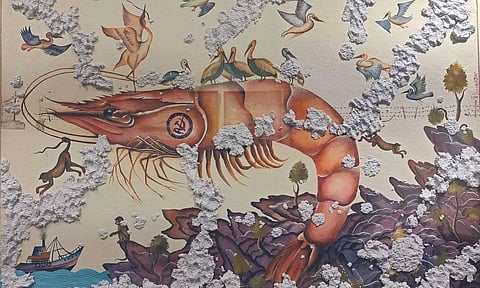

CHENNAI: Five artists from various parts of the country have come together to present an exhibition titled ‘Iconographic Echoes’. This captivating exhibition delves into the fusion of traditional iconography with contemporary artistic expression, offering a profound exploration of how heritage shapes modern art.
The participating artists at this ongoing exhibition at Apparao Galleries in Nungambakkam are Ravinder Dutt, N Ramachandran, Sitikanta Samantsingha, Madan Meena, and Srinivasa Reddy. Sitikanta Samantsinghar, hailing from the rural village of Alugaon near Chilika Lake in Odisha, draws inspiration from the social and ecological realities that have surrounded him since his college years.
His work is a testament to his dedication to addressing issues of social disparities, power structures in farming, and concerns about rural environment changes.
“I aim to create a visual dialogue that focuses on the politics of sustainability, and my philosophy is rooted in the spirit of compassion and understanding. Nowadays, I have been addressing issues related to ecology and conflicts arising from migration.
I have always been influenced by Chilika Lake, located nearby, where migration is a gamble, and birds and fish have to contend with various dangers on their journey, including bad weather, hungry predators, exhaustion, and starvation,” says Sitikanta. As an artist, Sitikanta Samantsinghar continually pushes boundaries and experiments with new forms and mediums.
“By blending traditional and contemporary elements in my exhibitions, I reach a broader audience, appealing to those interested in art history as well as enthusiasts of modern and avant-garde art. This fusion enables me to comment on current societal, political, or environmental issues by juxtaposing traditional symbols with modern concepts,” adds the artist. Interest in India’s cultural heritage varies from person to person.
Some individuals actively seek out opportunities to engage with their cultural heritage, while others may not prioritise it due to other commitments or interests. Sitikanta tells us that in today’s digital age, information is more accessible than ever, making it easier for people to explore and appreciate India’s rich history, art, and traditions.
“Artists and cultural organisations are actively working to promote India’s cultural heritage in innovative ways. They use various mediums, including art exhibitions, performances, digital platforms, and educational programs, to make cultural heritage more accessible and engaging for a broader audience.
Globalisation and increased cultural exchange can also impact how people perceive and engage with their heritage.” Another artist, Srinivasa Reddy, presents the Vahana series in this exhibition, which holds profound personal significance.
His upbringing in an ashram followed by further education in urban centres like Bengaluru and Chennai exposed him to a diverse range of social, political, and traditional influences.
“The Vahana series draws inspiration from traditional rituals where common people become the carriers of temple vahanas during city pradakshina (circumambulation) rituals and festivals.
The artwork captures the unique perspective of combining the traditional role of vahana carriers with the middle-class villagers who have migrated to growing cities for work. These pictures of me are composed of myself as a model, dressed as a labourer working in road or construction sites and combined with the wooden vahana of temples to serve the vahanas,” Reddy tells DT Next.
Artist Ravinder Dutt, who is also part of the exhibition, sees himself as a time traveller in the realm of art and existence. His diverse family origins, originating from Lahore and Kashmir, weave tales that resonate through his art. Ravinder finds solace in the world of fairy tales, palaces, antiques, and art.
“I draw inspiration from the Mughal, colonial, and contemporary eras, using age-old iconography to convey hidden meanings of the present. Art is a celebration of existence, bridging the traditions of the past with the technology of the present, all while weaving stories that blend reality with fiction,” opines Dutt.
According to the artist, traditions are what makes us what we are today. “I believe everything is recycled, remoulded from things or ideas which once formed a common collection of primordial thought.
The artist uses different mediums depending upon their interpretation of the world around them, circumstances and the world that existed before them and the future. We should never forget our roots - our traditions are what make us what we are today.
It is our traditions that form the core of anything that we do and the same goes for art. I bring in a lot of family history, stories from my ancestors, my great grandmother who lived for around 100 years and re-tell them at times hidden in layers in my art,” he adds.